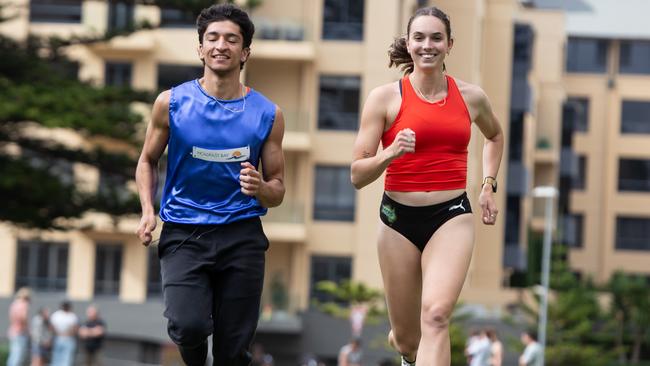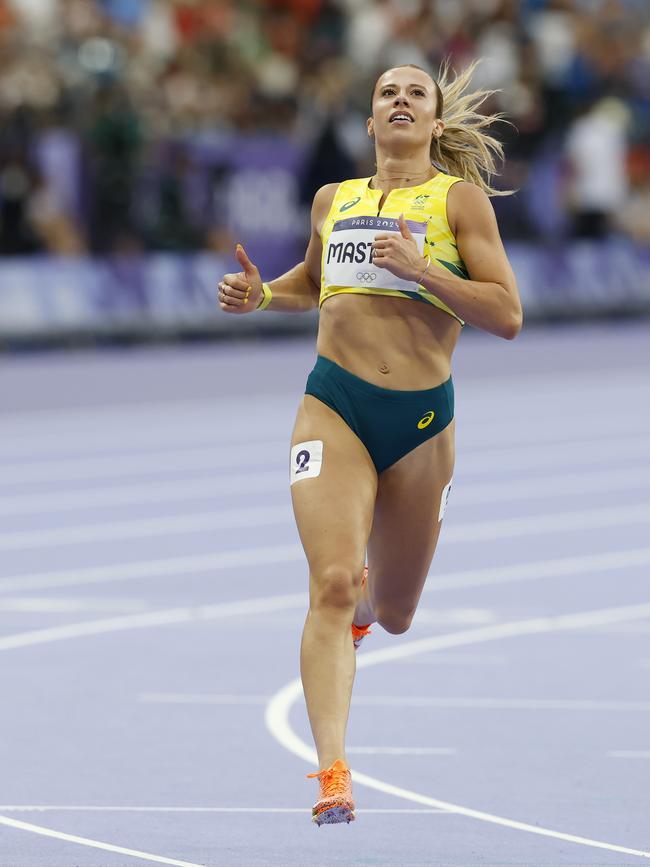The iconic Bay Sheffield after more than a century still gives mortals the closest thing to an elite athlete feeling | Cornes
With its first winner recorded back in 1887, an iconic Glenelg race still gives participants the closest feeling to an elite athlete, writes Graham Cornes.
Opinion
Don't miss out on the headlines from Opinion. Followed categories will be added to My News.
IN the heart of Glenelg, between Colley Terrace and the historic rotunda at the southern end of Colley Reserve is a path that commemorates each winner of the iconic Bay Sheffield.
The names, etched in the paving stones of the Bay Sheffield Walk, are slowly succumbing to the ravages of the wind, the sand and the salt. Barely legible is the name of R. Quinn, the first winner back in 1887. Would he care? He won the princely sum of 14 pounds.
According to a rough calculation, that’s worth about $2500 in today’s money.

He was a fair chance to win. In the then 100-yard race, he had a 10-yard start over the backmarker, a Mr P. Roberts who couldn’t beat the handicapper and finished third. Still, it would be nice if the tourists could read their names. Fortunately you can still read Brendon Wilson’s name. More about that later.
Over the years the distance of the race increased. First it was from 100 yards to 130 yards which was the distance between the two feuding English pubs in Sheffield that initiated a footrace as a way of settling their differences. Then, after we converted to the metric system, it became 120 metres; but not until 1972.
It is bemusing why sprinters and professional running holds such a personal fascination.
It’s not as though the Cornes family was blessed with fast-twitch fibres. We were lopers not sprinters. The explosive component was missing. Nevertheless, I loved sports day and the inter-school sports carnivals on the Fleurieu Peninsula, and competed enthusiastically.
But there was always someone from another school who was a little bigger, a little more developed and a lot faster. Yundi was such a small school but there was a kid called Kerry Smart from there who dominated those carnivals. I often wonder what happened to him. Did he pursue an athletic or sporting career?

So little has changed in the sport of professional running. It’s still athlete versus athlete which is probably why it holds such an appeal. There are no synthetic, polyurethane running tracks. It’s the same strip of grass that they were running on in 1887. Sure it’s been re-laid a few times but it’s still the same patch of ground on which you can have a kick with the kids at any time of the week – as dads did with their kids a century or more ago. The spiked shoes may be a little different, the shorts a little shorter and the singlets briefer but little has changed. The pro runners still run on footy ovals and public reserves right across the country.
The biggest change in professional running in recent years is the participation of female athletes. This year 60 women are competing compared to 71 men. Equal prize money and focus have given the women incentive to train and compete. Plus, as well as the pure athleticism be it male or female athletes, there is a definite glamour that adds to the appeal of the sport.
Women to watch this year are: Bella Pasquali, last year’s Stawell Gift winner, who won gold in the mixed 4x400, and silver in the women’s 4x400 relay at this year’s World Athletics U20 championships in Lima; Jess Milat who came fourth in the 200m in Lima; and Jordan McMillan who, at 14, was the youngest winner of the women’s Bay Sheff when she triumphed in 2018. Two-time Olympian Izzi Batt-Doyle will compete in the 1600 and 3200-metre events.
However, all eyes will be on Bree Masters. The 2024 Paris Olympian, who converted her childhood passion for dance into surf-lifesaving and beach sprinting, will run off scratch.
It’s hard to win off the back mark but she has 278,000 Instagram followers who will be supporting her.
Of the men, the back marker is 2022 winner Michael Moschou. The second back marker, off 2.75 metres is Anas Abu Ganaba who is coming from Queensland to compete for the second time. Archer McHugh who ran in the world U20 championships in Peru will also challenge but the more favoured athlete is Josh Love who has a good handicap (6 metres) and is in good form, having recently won the 70 and 100 metre events at Port Adelaide.
But the weekend is about more than the race itself.
The Bay Sheffield Hall of Fame was established to recognise extraordinary service and performance. As well as a recognition for the Bay Sheff, it rewards those whose contributions to professional running have been exceptional. Not all of the inductees have been athletes. Coaches, and administrators are honoured, as is Terry McAuliffe, the peerless announcer and commentator who surely works harder over the carnival than any of the athletes. But there are other names that leap from the list of previous inductees, all with great stories to tell.
Riley Wing, the Chinese-Australian athlete who survived the Japanese bombing of Darwin in 1942. He was playing football in Victor Harbor in a match umpired by Ernie Holder, who was also an athletic coach. Holder, who would later be inducted into the Hall of Fame himself, convinced Wing to take up professional running.
He won the Bay Sheff in 1947, the first of Holder’s five winners. Ken Hampton the long-limbed, graceful indigenous footballer from Pt Augusta and Whyalla won in 1961.
Bill Neil, our beloved Glenelg fitness coach of 1973 is in the Hall of Fame, as is basketballer, Al Green who lit up Apollo Stadium in the glory days of the Adelaide 36’ers. He won the Bay Sheff twice in 1983 and 1984. So many great names.
Hall of Fame recognition is a tremendous honour but occasionally there is someone who is worthy of higher recognition.
That’s why they have the “Legend” category. This morning Brendon Wilson will be elevated to Legend status in the Bay Sheffield Hall of Fame. His record is amazing, but just as amazing was his battle to survive and walk. When he was four, he contracted polio and needed to be strapped to an iron frame. For two years he was in hospital where the doctors feared he wouldn’t walk again. But slowly he recovered. Slowly he was inspired to run.
His father, Patrick, had been the state 440-yard champion.
Regular rail commuters would recognise him as the Man in Blue who, in another more congenial time, dispensed information at the Adelaide Railway Station. But Patrick and his sons, Brendon, Michael and Patrick jnr, ran. Slowly Brendon established himself as one of the state’s best sprinters. As well as the 1971 Bay Sheffield, he won 16 other gifts, 6 x70m, 2 x 200m and 9 x 400m professional races.
However, Brendon Wilson will tell you that his proudest achievements came after he turned 40 and amateur and professional athletics had unified. He was never defeated in America in the 40-45 year category, winning 36 gold medals. He won the world 200m title in Puerto Rico and at the age of 41 ran the 100m in Colorado in 10.68 seconds. He will be 82 in February, the honour coming as a worthy reward for someone who not only contributed to his sport, but also to society and community in his 32 years as a firefighter.
The Bay Sheff on Colley Reserve is a free event. It’s the closest we mortals will get to elite athletes. We can only dream, although I do have one great memory. Sitting proudly alongside my 1973 premiership team photo is a tiny 10cm trophy.
The brass plaque is tarnished and worn - but the inscription is still legible: “7RAR Inter Company Athletics Comp 440 yards Won by G.S. Cornes”.
Held on a windswept field at Holdsworthy Barracks in NSW, it was a long way from Colley Reserve and the Bay Sheff. That’s where the real athletes like Brendon Wilson inspire us.






